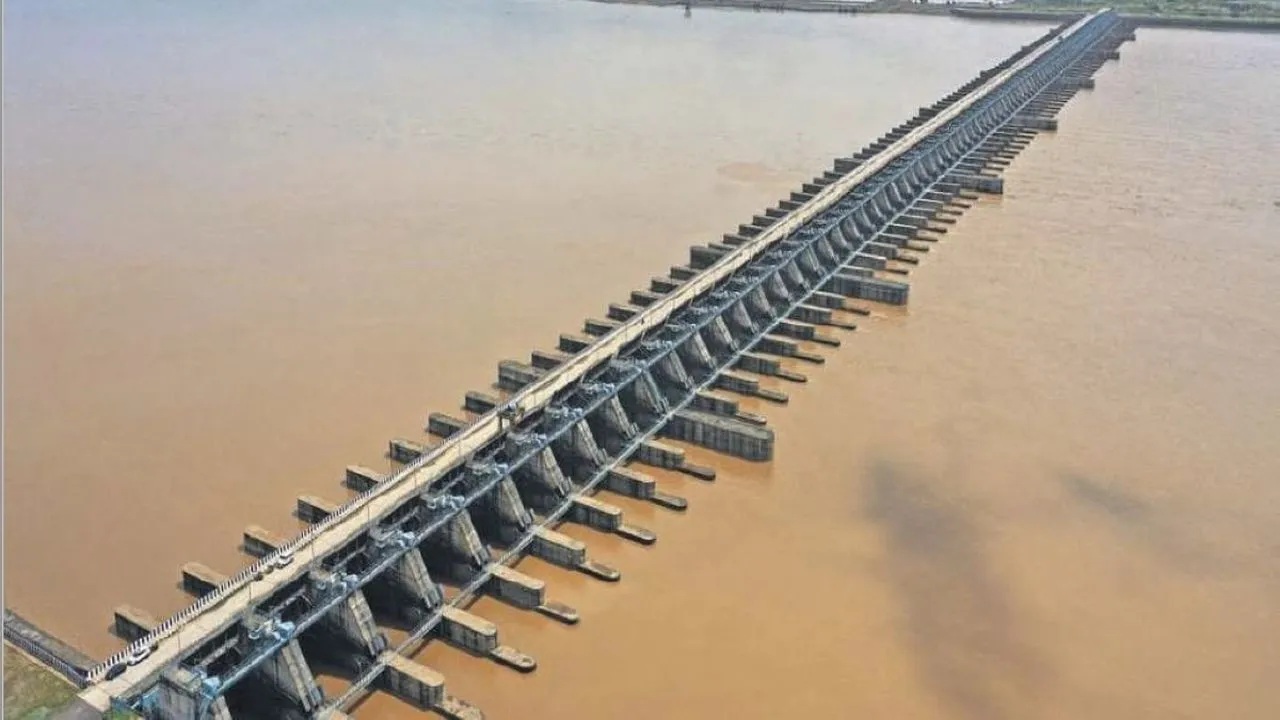Completed between 2018 and 2019, the KLIS developed severe structural problems within three years. Cracks appeared in the Annaram and Sundilla reservoirs, and the Medigadda barrage’s piers collapsed in October 2023.
Published Aug 04, 2025 | 9:50 PM ⚊ Updated Aug 04, 2025 | 9:50 PM

File photo of Medigadda barrage.
Synopsis: The Telangana cabinet has decided to table in the Legislative Assembly and Council the 635-page Justice Pinaki Chandra Ghose Commission report on the Kaleshwaram Lift Irrigation Scheme (KLIS), which details lapses in planning, construction and maintenance, and names former Chief Minister K Chandrasekhar Rao, former Irrigation Minister T Harish Rao and former Finance Minister Eatala Rajender as responsible for the project’s failure.
The Telangana cabinet has decided to present the 635-page Justice Pinaki Chandra Ghose Commission report on the Kaleshwaram Lift Irrigation Scheme (KLIS) in the state Legislative Assembly and Council.
The report, which examined allegations of negligence, financial irregularities and construction flaws in the Medigadda, Annaram and Sundilla barrages, held former Chief Minister K Chandrasekhar Rao, former Irrigation Minister T Harish Rao, and former Finance Minister Eatala Rajender responsible for major lapses that, it said, led to the project’s failure and a massive waste of public money.
Following a detailed briefing by Irrigation Minister N Uttam Kumar Reddy at the State Secretariat during the cabinet meeting on Monday, 4 August, Chief Minister A Revanth Reddy said the government expected Leader of the Opposition K Chandrasekhar Rao and former Irrigation Minister Harish Rao, both members of the Assembly, to respond to the report’s findings.
The chief minister said that the KLIS, envisaged as Telangana’s lifeline, had ballooned from the initial ₹38,000 crore estimated for the earlier Pranahita-Chevella scheme to more than ₹1,10,000 crore, with loans raised at high interest rates, including off-market borrowings.
When the Medigadda barrage piers collapsed in October 2023, the Congress promised a judicial inquiry as part of its 2023 Assembly election promises. The Ghose Commission was appointed on 14 March 2024.
The KLIS, launched by the Bharat Rashtra Samithi (BRS, formerly TRS) government in 2015-16, replaced the Pranahita-Chevella scheme initiated in 2007-08 under then Chief Minister YS Rajasekhara Reddy.
The original project, planned at Tummidi Hatti in Adilabad district, aimed to irrigate 16.5 lakh acres at an estimated cost of ₹38,000 crore. By then, ₹11,000 crore had already been spent.
The Justice Pinaki Chandra Ghose Commission report
However, the BRS government shifted the site to Medigadda, a move the Commission described as driven by Rao’s “predetermination” rather than a government consensus. The claim that Tummidi Hatti lacked sufficient water was termed “insincere and dishonest.”
An expert committee of retired and serving chief engineers, constituted by Rao, had advised against Medigadda citing prohibitive costs and an unsuitable location. According to the Commission, this report was suppressed, and the project went ahead without cabinet approval, violating the government’s business rules.
The decision to construct barrages at Medigadda, Annaram and Sundilla was attributed solely to Chandrasekhar Rao and Harish Rao, bypassing established procedures.
Completed between 2018 and 2019, the KLIS developed severe structural problems within three years. Cracks appeared in the Annaram and Sundilla reservoirs, and the Medigadda barrage’s piers collapsed in October 2023.
Following the Medigadda failure, the National Dam Safety Authority (NDSA) flagged lapses in planning, construction and maintenance, and called for an inquiry. The Ghose Commission upheld these concerns, noting a “complete absence” of operation and maintenance, including the lack of pre and post monsoon inspections.
It found that Chandrasekhar Rao’s instruction to keep the barrages full to operate pump houses, despite their design as diversion structures, was a key factor in the damage.
The project’s estimated cost rose from ₹84,000 crore to over ₹1,10,000 crore by 2022, driven by revised administrative approvals that the Commission described as “malicious” and intended to benefit contractors.
The Commission’s report, distilled by a three-member committee comprising the secretaries of irrigation, general administration and law, explicitly names K Chandrasekhar Rao 32 times, T Harish Rao 19 times, and Eatala Rajender five times.
Chandrasekhar Rao is held “directly and vicariously accountable” for irregularities in planning, construction, completion and operation and maintenance (O&M), with his “minute involvement” cited as a factor in the barrages’ distress.
Harish Rao is named for suppressing the expert committee’s report, while Rajender is indicted for negligence and for feigning ignorance during testimony, including a false claim that the cabinet had cleared the barrages. The report recommends severe action against those who suppressed expert advice or gave false statements.
Chief Minister Revanth Reddy described the KLIS failure as a major governance lapse, saying that a project intended to irrigate unserved farmlands had instead become a financial burden on Telangana. He said the cabinet’s decision to table the report was aimed at enabling a transparent debate, and urged all members of both Houses of the Telangana Legislature to express their views.
He also said the Congress government had honoured a commitment made by Rahul Gandhi during his visit to the collapsed Medigadda site.
The Ghose Commission’s terms of reference included probing negligence, irregularities in awarding contracts, financial indiscipline, failures in O&M, lack of quality control, and undue benefits extended to contractors.
(Edited by Dese Gowda)
